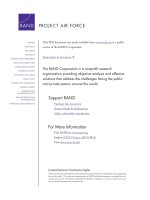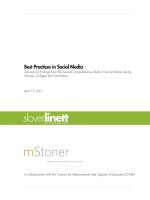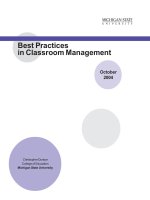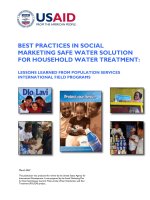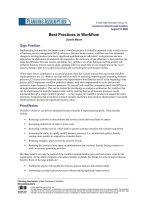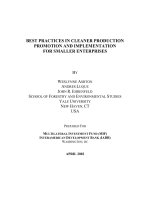BEST PRACTICES IN SOCIAL MARKETING SAFE WATER SOLUTION FOR HOUSEHOLD WATER TREATMENT: LESSONS LEARNED FROM POPULATION SERVICES INTERNATIONAL FIELD PROGRAMS ppt
Bạn đang xem bản rút gọn của tài liệu. Xem và tải ngay bản đầy đủ của tài liệu tại đây (1.14 MB, 81 trang )
March 2007
This publication was produced for review by the United States Agency for
International Development. It was prepared by the Social Marketing Plus
for Diarrheal Disease Control: Point-of-Use Water Disinfection and Zinc
Treatment (POUZN) project.
BEST PRACTICES IN SOCIAL
MARKETING SAFE WATER SOLUTION
FOR HOUSEHOLD WATER TREATMENT:
LESSONS LEARNED FROM POPULATION SERVICES
INTERNATIONAL FIELD PROGRAMS
POUZN Research Report No. 2
POUZN Research Report Series: POUZN’s research report series addresses important issues of childhood
diarrhea prevention and management focusing on point-of-use water disinfection and zinc treatment. The papers
are disseminated to a broad audience, including donor agency representatives, commercial and private sector
partners, policy makers, technical advisors and researchers. POUZN staff and external experts review all papers.
Recommended Citation: POUZN Project. March 2007. Best Practices in Social Marketing Safe Water Solution for
Household Water Treatment: Lessons Learned from Population Services International Field Programs. The Social Marketing
Plus for Diarrheal Disease Control: Point-of-Use Water Disinfection and Zinc Treatment (POUZN) Project, Abt
Associates Inc., Bethesda, MD.
Social Marketing Plus for Diarrheal Disease Control: Point-of-use Water Disinfection and Zinc Treatment
(POUZN) is a five-year task order, under USAID’s Private Sector Program (PSP) indefinite quantity contract.
POUZN works globally to introduce and scale-up low-cost point-of-use (POU) water treatment products and
zinc, a new effective treatment for diarrhea, for the reduction of child morbidity and mortality from diarrhea.
For more information contact:
Download: Download copies of POUZN publications at: www.pouzn.com, www.ehproject.org, or www.dec.org
or />
Cover Photos by: Population Services International
Photographs throughout the report supplied by the courtesy of the U.S. Centers for Disease Control and Prevention and
Population Services International
Contract/Project No.: GPO-I-00-04-00007-00 Task Order 5
Submitted to: John Borrazzo, Environmental Health Team Leader
Office of Health, Infectious Disease and Nutrition
Bureau for Global Health
U.S. Agency for International Development
Washington, D.C. 20523-3700
Abt Associates Inc. 4800 Montgomery Lane, Suite 600
Bethesda, Maryland 20814 Tel: 301.913-0500. Fax: 301.828-9633
www.abtassoc.com
In collaboration with:
Population Services International
DISCLAIMER
The authors’ views expressed in this publication do not necessarily reflect the views of the United
States Agency for International Development (USAID) or the United States Government
BEST PRACTICES IN SOCIAL
MARKETING SAFE WATER SOLUTION
FOR HOUSEHOLD WATER TREATMENT:
LESSONS LEARNED FROM POPULATION SERVICES
INTERNATIONAL FIELD PROGRAMS
iii
ABSTRACT
Since 1998, Population Services International, with the funding and support of the U.S. Agency
for International Development and other donors, has been involved in the implementation of
safe water programs in 20 developing countries, promoting the Safe Water System (SWS), a
household water treatment and safe storage strategy originally designed by the U.S. Centers for
Disease Control and Prevention in response to cholera outbreaks in Latin America. SWS
includes three elements: (1) water treatment at point-of-use with a dilute sodium hypochlorite
(chlorine) “safe water” solution; (2) storage of water in a safe container, and (3) education to
improve hygiene and water use practices.
This paper synthesizes lessons learned, best practices, successes, and challenges of social
marketing safe water solution, and discusses how these lessons may be applied to planning safe
water treatment programs around the globe.
Key words: household water treatment, household water quality, diarrhea prevention, safe
drinking water, point-of-use water treatment
v
CONTENTS
Acronyms vii
Acknowledgments ix
Executive Summary xi
Introduction 1
Section 1: Project Design 7
Section 2: Production of Product Components 11
Section 3: The Regulatory Environment 21
Section 4: Marketing and Communications 25
Section 5: Sales and Distribution 37
Section 6: Creating Partnerships 41
Section 7: Product Costs, Pricing, and Cost Recovery 45
Section 8: Integrating Water Treatment Products into
HIV/AIDS Programming 47
Recommendations and Conclusions 51
Appendix A: POUZN Lessons Learned Questionnaire 55
Appendix B: CDC Fact Sheet: Disinfection By-Products and
the Safe Water System 59
Appendix C: Reference Materials and Interviews 61
vii
ACRONYMS
ARV Anti-retroviral (therapy) for HIV/AIDS
BCC Behavior change communication
CBD Community-based distribution
CDC U.S. Centers for Disease Control and Prevention
COGS Cost of goods sold
GAP Global AIDS Program
HIV/AIDS Human immunodeficiency virus/acquired immunodeficiency syndrome
HWTS Household water treatment and safe storage
KfW Kreditanstalt für Wiederaufbau
(German government–owned development
bank)
KSH Kenya shilling
MDG United Nations Millennium Development Goals
MOH Ministry of Health
MOW Ministry of Water
NGO Nongovernmental organization
NTU Nephelometric turbidity units
OFDA Office of Foreign Disaster Assistance (USAID)
PAHO Pan American Health Organization
PEPFAR United States President’s Emergency Plan for AIDS Relief
PLWHA Persons living with HIV/AIDS
PMTCT Prevention of mother-to-child transmission
POU Point-of-use
POUZN Social Marketing Plus for Diarrheal Disease Control: Point-of-Use Water
Disinfection and Zinc Treatment Project
PSI Population Services International
PUR® Procter & Gamble product for clarifying and disinfecting turbid water
SWS Safe Water System
UNICEF United Nations Children’s Fund
USAID United States Agency for International Development
WHO World Health Organization
ix
ACKNOWLEDGMENTS
The following individuals contributed to the authorship of this paper: Abt Associates: Vicki
MacDonald, Susan Mitchell; Population Services International: Chuck Szymanski; U.S. Centers
for Disease Control and Prevention: Daniele Lantagne; and Jennifer C. Peters, independent
consultant.
PSI field staff interviewed: Carmen Chan (India), Nils Gade (Tanzania and Zambia), Brad Lucas
(Zambia and Tanzania), David McAfee (Madagascar), Guy Stallworthy (Myanmar), Chelsea
Treadwell (Malawi), and David Walker (Kenya).
The authors would also like to thank John Borrazzo and Rochelle Rainey of USAID and Robert
Quick of the CDC for their thoughtful comments and suggestions.
x
i
EXECUTIVE SUMMARY
The health consequences of inadequate water supply, sanitation, and hygiene are an estimated 4
billion cases of diarrhea, epidemics of waterborne infectious diseases such as cholera, and 1.8
million deaths each year, mostly among young children in developing countries, highlighting the
need for effective public health strategies to prevent diarrhea.
As part of its global leadership mandate, the U.S. Agency for International Development
(USAID)’s Social Marketing Plus for Diarrheal Disease Control: Point-of-Use Water
Disinfection and Zinc Treatment (POUZN) Project, implemented by Abt Associates and
Population Services International (PSI), led this effort to gather lessons learned from PSI’s eight
years of field experience implementing safe water programs in 20 countries.
In the 1990s, the U.S. Centers for Disease Control and Prevention (CDC), based on a series of
field trials and published documentation, developed a household water treatment and safe
storage strategy, the Safe Water System (SWS), that includes three elements: (1) water
treatment at point-of-use (POU) with a dilute sodium hypochlorite (chlorine) solution; (2)
storage of water in a safe container, and (3) education to improve hygiene and water use
practices. This household water treatment program is rapid to implement, low-cost, and can be
carried out on a national or regional scale. Household water treatment programs are also
complementary to infrastructure development projects that improve the supply of water but
cannot guarantee safe water quality at the household level.
PSI, one of the largest social marketing organizations in the world, was involved with the design
and testing of the first SWS trials and has since implemented safe water programs in 20
developing countries. This paper synthesizes lessons learned, best practices, successes, and
challenges of safe water solution social marketing programs and discusses how these lessons
may be applied to planning safe water treatment programs around the globe. Summarized
below are the main lessons from PSI’s experience social marketing the safe water system:
Project Design: Three factors are critical to initiating a safe water system project: (1)
identifying appropriate target group(s) with high incidence of waterborne diseases, yet sufficient
resources to regularly purchase the product; (2) establishing a stable funding base to ensure
program sustainability; and (3) recruiting and assembling the human resource expertise needed
to develop and support a safe water program.
• Lesson 1.1: The target group must meet the dual criteria of health needs and private sector
viability
• Lesson 1.2: A long-term funding strategy should be developed
• Lesson 1.3: A range of technical expertise is needed
xii
Production of Safe Water Product Components: Key factors to ensure a high-quality
product include locating, arranging for, and monitoring local production by companies with the
required specialized technical knowledge; establishing stringent, ongoing quality control at
program outset; setting appropriate expiration dates for the product; and correctly determining
the chlorine dosage. Standardizing the product packaging into a 150 mL plastic bottle with a 3
mL cap, with the sodium hypochlorite concentration modified to meet the dosage needs in
each country, has led to a more easily produced, transported, usable, and affordable product.
• Lesson 2.1: Arranging local production is not easy but is ultimately critical to sustainability
and cost-effectiveness
• Lesson 2.2: Ongoing quality monitoring is essential
• Lesson 2.3: Product shelf life is important to market acceptance
• Lesson 2.4: Correct chlorine dosage is the key to product viability
• Lesson 2.5: Standardization of plastic containers simplifies program implementation and
reduces program costs
• Lesson 2.6: Packaging must be appropriate for rural transportation and distribution
The Regulatory Environment: The approval of all relevant government ministries is an
essential step in securing product registration, ensuring the product’s long-term sustainability
in-country, and maintaining collaboration with other government programs. Program staff must
be prepared to respond to technical questions about the product in a timely and technically
sound manner.
• Lesson 3.1: Involve all relevant government agencies early in the process
• Lesson 3.2: Respond immediately to government concerns
• Lesson 3.3: Prepare program staff to respond to technical questions about the product
Marketing and Communications: Marketing and communications efforts are critical for
helping people understand the relationship between untreated water and diarrhea, the
importance of treating household water, and the need for sustained, consistent product use.
The associated behavior change challenge is significant, requiring time, a sustained investment,
and a range of approaches. Identifying the appropriate target group(s) and channels of
communication in peri-urban and rural areas is critical to this effort. Safe water program
campaigns need to be aspirational in nature and complement other diarrheal disease prevention
and treatment campaigns.
• Lesson 4.1: Shifting the focus of product launch to rural communities with unsafe water and
sanitation has been very effective in enhancing product prestige
x
iii
• Lesson 4.2: Communications must address specific safe water program behavioral
constructs
• Lesson 4.3: The branded marketing campaign should be positive and aspirational
• Lesson 4.4: Safe water campaign messages need to be complementary to related campaigns
• Lesson 4.5: Timing of a safe water product launch affects success
• Lesson 4.6: Choosing the most appropriate communication channels is highly context-
specific
• Lesson 4.7: Targeted technical information can address concerns about dangers of chlorine
use
• Lesson 4.8: Behavior change for safe water use is a long process, requiring sustained funding
• Lesson 4.9: Marketing templates (such as labels) can be developed and adapted to local
requirements
Sales and Distribution: The commercial sector in most developing countries provides an
efficient vehicle for large-scale distribution of essential household items to the urban and peri-
urban markets where women purchase most household goods. However, ensuring that the
product reaches the retailer is not enough. A consistent “push” – through point-of-sale
materials that call attention to the product – is needed to keep the product in the forefront of
retailer displays and consumer minds. Partner non-governmental organization (NGO) volunteer
or community-based distribution networks can assist with promotion and distribution and
significantly improve rural penetration. Successful programs can encourage commercial firms to
enter the market with their own brands.
• Lesson 5.1: While the commercial sector will distribute the safe water product, program
success requires a complementary “push” from the project
• Lesson 5.2: Capitalizing on NGO networks can significantly improve rural penetration
• Lesson 5.3: Entry of a socially marketed safe water product can encourage commercial
sector participation
Creating Partnerships: The cultivation of partnerships has not only strengthened political
support for safe water programs but has also increased product sales among target populations.
• Lesson 6.1: Partnerships are vital to the successful adoption of the safe water program at all
levels
• Lesson 6.2: Donor advocacy and support can make a considerable contribution to the
success of safe water programs
xiv
• Lesson 6.3: With appropriate coordination and training, NGO programs can offer a wealth
of opportunities for reaching rural and high-risk populations
• Lesson 6.4: Trusted spokespersons and product champions are fundamental to product
adoption
Product Costs, Pricing, and Cost Recovery: It is a careful balancing act to set an
affordable consumer price that recovers production costs, minimizes subsidies, and yet
provides key target populations access to the product.
• Lesson 7.1: Product cost may be recovered through sales
• Lesson 7.2: In most countries, product subsidies are not necessary
Integrating Safe Water into HIV/AIDS Programming: The provision of safe drinking
water is critical in support for persons living with HIV/AIDS (PLWHA) since they are
particularly susceptible to opportunistic infections and diarrhea. Partnering with NGOs that
provide care to PLWHA has been a successful model for reaching this target group.
• Lesson 8.1: Partnering with local NGOs that provide care for persons living with HIV/AIDS
has been a successful model for reaching PLWHA
• Lesson 8.2: Interest in reaching PLWHA can provide the stimulus for a national safe water
campaign
Household-level point-of-use water treatment has been shown to significantly reduce diarrheal
diseases in vulnerable populations and should become an essential intervention within child
survival, HIV/AIDS, and water supply programs. While challenges remain, such as ensuring
consistent product use and program financial sustainability, the key elements in implementing
household water treatment programs using safe water solution are now quite well understood.
These and other evidence-based POU water treatment programs should be scaled up and
expanded throughout the developing world, filling a critical public health gap in drinking water
quality.
1
INTRODUCTION
In September 2000, the United Nations General Assembly adopted Millennium Development
Goals (MDG) to promote “human development as the key to sustaining social and economic
progress.” One MDG target is to “halve, by 2015, the proportion of people without sustainable
access to safe drinking water and basic sanitation.” Even if that goal is met, more than 600
million people will still lack access to safe water in 2015. Moreover, although the MDG target
specifically calls for the provision of “safe” drinking water, the yardstick for assessing progress
toward that target is provision of water from “improved” sources, such as boreholes or
household connections. Because post-source contamination is so prevalent, it is difficult to
assess whether water is actually safe at the household level even for people who currently
obtain drinking water from improved sources.
The health consequences of inadequate water supply, sanitation, and hygiene are an estimated 4
billion cases of diarrhea, epidemics of waterborne infectious diseases such as cholera, and 1.8
million deaths each year, mostly among young children in developing countries, highlighting the
need for effective public health strategies that can keep water safe and prevent diarrhea.
HOUSEHOLD WATER TREATMENT AND POINT-OF-USE
CHLORINATION
Since 1996, a large body of published work has examined the health impact of interventions to
improve water quality at the point-of-use (POU) through household water treatment and safe
storage (HWTS). The results of these studies, including several randomized controlled
intervention trials, have highlighted the public health implications of post-source contamination
of drinking water during collection, transport, and storage and the health value of effective
HWTS. A recent meta-analysis found that hygiene education and water quality interventions
were effective in reducing diarrheal disease by 42 and 39 percent, respectively.
1
In 2003, as the evidence base for the health benefits of various HWTS methods accumulated,
academic and government institutions, nongovernmental organizations (NGOs), and private
sector organizations that support or engage directly in research and implementation of novel
HWTS approaches formed the International Network to Promote Household Water
Treatment and Safe Storage, with a secretariat hosted by the World Health Organization
(WHO) in Geneva, Switzerland. Its stated goal is “to contribute to a significant reduction in
waterborne disease, especially among vulnerable populations, by promoting household water
treatment and safe storage as a key component of water, sanitation and hygiene programmes.”
1
Fewtrell L., Colford, J.M. Water, Sanitation, and Hygiene: Interventions and Diarrhoea, a Systematic Review and Meta-
Analysis. Washington, DC: World Bank HNP Discussion Paper, July 2004.
2
The Network serves as a forum for professional collaboration and is an excellent resource for
those interested in starting water treatment programs.
2
The five common household water treatment options are chlorination, filtration (biosand and
ceramic), solar disinfection, combined filtration/chlorination, and combined
flocculation/chlorination.
Chlorination was first used for disinfection of public water supplies in the early 1900s,
contributing to dramatic reductions in waterborne disease in cities in the developed world.
Although small trials of point-of-use chlorination had been implemented, larger-scale trials
began in the 1990s as part of the Pan American Health Organization and CDC’s response to
epidemic cholera in Latin America.
The Safe Water System (SWS) developed by the CDC includes three elements:
1. A water treatment product consisting of a dilute sodium hypochlorite (chlorine) solution,
referred to throughout this document as the safe water solution or “the product;”
2. Storage of water in a safe container; and
3. Education to improve hygiene and water use practices.
In randomized controlled trials, use of the SWS has resulted in diarrheal disease risk reduction
from 26 to 84 percent, with an approximate average reduction of 50 percent.
3
PSI AND THE SAFE WATER SYSTEM PROGRAM
With offices in more than 60 countries, PSI is one of the world’s largest social marketing
NGOs. PSI designs a brand name and logo for health products and services, sells them at
affordable prices, distributes them through wholesale and retail commercial and public sector
networks, and generates demand for the products through behavior change campaigns (BCC)
that make use of radio and television spots, mobile video units, point-of-sale materials,
theatrical performances, and interpersonal communication. PSI’s primary areas of focus are
HIV/AIDS, malaria, family planning, and maternal and child health.
In 1996 and 1997, PSI was involved in the design and testing of the first safe water project with
the CDC. The CDC developed and tested a prototype SWS pilot in Bolivia, and PSI fielded the
first commercial application. Controlled trials confirmed that use of the SWS reduces the
incidence of diarrhea under field conditions. In Bolivia, a five-month field test led to 44 percent
fewer diarrhea episodes in intervention versus control households.
4
PSI, with continuing
2
The Network can be accessed at www.who.int/household_water/
3
Wright J., Gundry S., Conroy R. Household Drinking Water in Developing Countries: A Systematic Review of
Microbiological Contamination between Source and Point-of-Use. Tropical Medicine and International Health, January 2004;
9(1):106-117.
4
Quick R. et al. Diarrhea Prevention in Bolivia through Point-of-Use Disinfection and Safe Storage: A Promising New
Strategy. Atlanta: U.S. Centers for Disease Control and Prevention, 1999.
3
technical support from the CDC, has since applied the lessons learned from the Bolivia pilot
program to expand the social marketing of the SWS throughout the developing world.
5
(Figure
1, below, presents a map of current PSI safe water program countries.)
FIGURE 1: CURRENT PSI SAFE WATER PROGRAMS
PSI launched its first two large-scale safe water programs in Zambia and Madagascar in the
midst of public health emergencies – a cholera epidemic in Zambia and a cholera epidemic
followed by three consecutive cyclone emergencies in Madagascar. Both efforts have
successfully developed into ongoing programs promoting a dilute chlorine solution for everyday
use. In Zambia, sales steadily increased from 732 bottles of safe water solution per month in
October 1998 to 155,000 bottles per month in June 2006.
To date, PSI has launched safe water programs in 20 countries, as detailed in the following
table.
5
Initial PSI programs included the marketing of both the safe water solution and an accompanying water storage
container. Due to high production and transport costs associated with marketing storage containers, this practice was
discontinued. Promotion of appropriate storage and targeted behavior change communication campaigns remain essential
elements of the program.
4
TABLE 1: PSI SAFE WATER PROGRAM COUNTRIES IN ORDER OF LAUNCH DATE
Country Date Launched Funding sources 2005 Sales
(bottles)
Cumulative Sales
(bottles)
Zambia November 1998 PEPFAR, CDC, USAID
1,835,088 9,531,959
Madagascar March 2000 CDC, USAID
705,554 3,164,557
Tanzania July 2002 PSI
140,466 811,297
Rwanda August 2002 PSI, Government of Rwanda,
USAID
66,293 323,394
Malawi December 2002 PSI, USAID,
666,298 2,222,302
Kenya May 2003 PSI, USAID
832,106 2,088,670
Afghanistan June 2003 USAID, CDC
367,501 535,580
Burkina Faso February 2004 PSI
1,505 21,850
India April 2004 USAID
95,498 211,987
Myanmar July 2004 UNICEF, WHO, PSI
92,193 169,852
Uzbekistan July 2004 PSI
9,890 16,320
Mozambique November 2004 PSI, USAID, Government of
the Netherlands
207,517 374,820
Nigeria November 2004 PSI, USAID
495,554 959,793
Uganda August 2005 CDC, PEPFAR, PSI
95,543 383,129
Nepal October 2005 PSI
152,661 249,881
Vietnam November 2005 PSI
26,712 93,772
Ethiopia December 2005 USAID
N/A 429,163
Burundi March 2006 USAID
N/A 34,244
Guinea July 2006 KfW
N/A N/A
Cameroon November 2006 CDC
N/A N/A
Source: PSI. PEPFAR=President’s Emergency Plan for AIDS Relief; KfW=Kreditstalt fr Wiederaufbau
Seventeen of the programs are ongoing. Two, Uzbekistan and Burkina Faso, have been
discontinued due to lack of funding; Afghanistan has been transferred to another project.
As part of its global leadership mandate, USAID’s Social Marketing Plus for Diarrheal Disease
Control: Point-of-Use Water Disinfection and Zinc Treatment (POUZN) Project, implemented
by Abt Associates and PSI, led this effort to gather lessons learned from PSI’s eight years of field
experience implementing safe water programs in 20 countries. This paper synthesizes lessons
learned, best practices, successes, and challenges of safe water programs worldwide and
discusses how these lessons may be applied to planning POU safe water treatment programs
around the globe.
5
METHODOLOGY
This paper is based on a review of secondary research and other technical reports produced by
PSI and CDC and summarizes interviews with PSI and CDC staff. Appendix A includes the
interview guide while Appendix C includes a full list of references and individuals interviewed.
Based on the information gathered, the paper presents lessons learned in the following
categories:
• Project Design
• Product Development
• Policy/Regulatory Environment
• Marketing and Behavior Change Campaigns
• Sales and Distribution
• Partnerships and Linkages
• Product Costs, Pricing, and Cost Recovery
• HIV/AIDS and the Safe Water Programs
A final section presents a summary of recommendations and conclusions.
